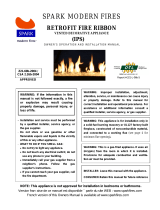
www.fmiproducts.com
111826-04E 7
AIR FOR COMBUSTION AND VENTILATION
Continued
40,000
33,000
73,000
Conned and Unconned Space
The National Fuel Gas Code, ANSI Z223.1/
NFPA 54 denes a conned space as a space
whose volume is less than 50 cubic feet per
1,000 Btu per hour (4.8 m
3
per kw) of the ag-
gregate input rating of all appliances installed in
that space and an unconned space as a space
whose volume is not less than 50 cubic feet per
1,000 Btu per hour (4.8 m
3
per kw) of the ag-
gregate input rating of all appliances installed in
that space. Rooms communicating directly with
the space in which the appliances are installed*,
through openings not furnished with doors, are
considered a part of the unconned space.
* Adjoining rooms are communicating only if
there are doorless passageways or ventilation
grills between them.
DETERMINING FRESH-AIR FLOW
FOR HEATER LOCATION
Determining if You Have a Conned or
Unconned Space
Use this work sheet to determine if you have
a conned or unconned space.
Space: Includes the room in which you will
install heater plus any adjoining rooms with
doorless passageways or ventilation grills
between the rooms.
1. Determine the volume of the space (length
x width x height).
Length x Width x Height =__________cu. ft.
(volume of space)
Example: Space size 20 ft. (length) x 16 ft.
(width) x 8 ft. (ceiling height) = 2,560 cu. ft.
(volume of space)
If additional ventilation to adjoining room is sup-
plied with grills or openings, add the volume of
these rooms to the total volume of the space.
2. Multiply the space volume by 20 to determine
the maximum Btu/Hr the space can support.
________ (volume of space) x 20 = (Maxi-
mum Btu/Hr the space can support)
Example: 2,560 cu. ft. (volume of space) x
20 = 51,200 (maximum Btu/Hr the space can
support
)
3. Add the Btu/Hr of all fuel burning appliances
in the space.
Vent-free replace _________ Btu/Hr
Gas water heater* _________ Btu/Hr
Gas furnace _________ Btu/Hr
Vented gas heater _________ Btu/Hr
Gas replace logs _________ Btu/Hr
Other gas appliances* + ________ Btu/Hr
Total = _________ Btu/Hr
* Do not include direct-vent gas appliances.
Direct-vent draws combustion air from the
outdoors and vents to the outdoors.
Example:
Gas water heater _________ Btu/Hr
Vent-free replace + _________ Btu/Hr
Total = _________ Btu/Hr
4. Compare the maximum Btu/Hr the space
can support with the actual amount of Btu/
Hr used.
_______
Btu/Hr (maximum the space can sup-
port)
________
Btu/Hr (actual amount of Btu/Hr
used)
Example: 51,200 Btu/Hr (maximum the
space can support)
73,000 Btu/Hr (actual amount of
Btu/Hr used)
The space in the above example is a conned
space because the actual Btu/Hr used is more
than the maximum Btu/Hr the space can sup-
port. You must provide additional fresh air. Your
options are as follows:
A. Rework worksheet, adding the space of an
adjoining room. If the extra space provides
an unconned space, remove door to adjoin-
ing room or add ventilation grills between
rooms. See Ventilation Air From Inside
Building, page 8.
B. Vent room directly to the outdoors. See
Ventilation Air From Outdoors, page 8.
C. Install a lower Btu/Hr replace, if lower Btu/
Hr size makes room unconned.
If the actual Btu/Hr used is less than the maxi-
mum Btu/Hr the space can support, the space is
an unconned space. You will need no additional
fresh air ventilation.
WARNING: If the area in
which the heater may be oper-
ated does not meet the required
volume for indoor combustion
air, combustion and ventilation
air shall be provided by one of
the methods described in the
National Fuel Gas Code, ANSI
Z223.1/NFPA 54, the Internation-
al Fuel Gas Code, or applicable
local codes.


























